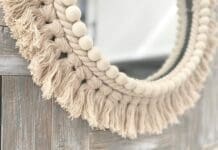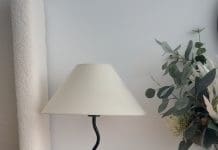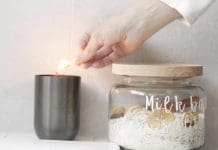Supported by The Reject Shop
The latest interiors trend taking over the wall art space are herbariums!
What is a herbarium you may be wondering? They are similar to displaying pressed flowers or leaves but the sample sizes are generally much larger so you can see how a plant branches or blooms, and they have a detailed label with information about the species, where and when it was collected, and by whom.
Herbariums are typically found in universities or botanical gardens for research purposes but have found their way into the interiors space and today I’m going to show you 3 easy techniques you could use to make your own.
I sourced all of the items for this DIY from The Reject Shop and depending on the size frame you purchase, you could make your own herbarium for as little as $15!
Watch this quick video to see how easy it is or continue reading for step-by-step instructions below.
Related article: Quick fixes and DIY hacks for home repairs and maintenance
Related article: DIY solar installs: Balancing savings with safety and compliance
Items you will need:
- Freshly picked plant or flower cuttings (these should be significant in size and not just the flowers, see the tips section below)
- Frames (all of ours are from The Reject Shop)
- Several sheets of clean blank paper
- Sheet of white cardboard large enough to fit frame
- Large hardcover books or other weights
- Craft glue
- Paint brush
- White tape and pen for handwritten labels, or computer and printer for printed labels
Steps
Technique 1 – Pressed and framed in glass
1. Carefully press your cuttings in between two sheets of white paper and place heavy books or other weights on top. Leave to dry out for 3-7 days depending on your climate.
2. Once dry, place your specimens in between the two sheets of glass, being sure to leave enough space for your label (ideally this should be in the bottom right corner).
3. Secure your label in between the sheets of glass. You may need to use glue to ensure it doesn’t move, as the paper will be thinner than your plant sample.
4. Slide the glass sheets back into the frame and display your herbarium in your home!

Technique 2 – Dried and placed in box frame
1. This technique is ideal for plants with berries or seeds that you want to keep in tact. Simply allow the cutting to dry out fully, which could take up to several weeks.
2. Once dry, it will become brittle so handle with care. Place it inside your box frame and secure your label. I didn’t use any glue to keep the dried branch in place but you may need to use a few spots of glue depending on the size of your sample and frame.
3. Mount your artwork in your home and appreciate the depth and detail of this beautiful herbarium.

Technique 3 – Pressed and framed on white cardboard
1. Carefully press your cuttings in between two sheets of white paper and place heavy books or other weights on top. Leave to dry out for 3-7 days depending on your climate.
2. Then arrange your specimens on the A3 sheet of cardboard. If you are placing several specimens in the one frame, it looks best when the bottoms of the stems line up but you can arrange these however you like.
3. Carefully glue all the specimens in place using the craft glue and a paintbrush.
4. Glue your label/s in place.
5. Finally, mount your artwork in your home and appreciate how the specimens change colour over time.

Tips:
- Unlike pressed flowers, a herbarium is supposed to be a large enough cutting (sample) that you can see what type of plant it is, its manner of growth, branching and so on. So be sure to take a significant cutting size that includes several branches.
- For the best sample, it’s important to press your specimens as quickly as possible.
- Be mindful that you may need to seek permission before collecting samples, so check the rules in your local area.
What do you think of this inexpensive wall art idea? I love how they bring elements of nature into the home and also a sculptural quallity.
If you enjoyed this DIY video, you can find more on our YouTube channel here or check out The Reject Shop blog for even more savvy home decorating and DIY ideas.








